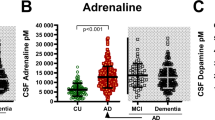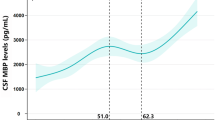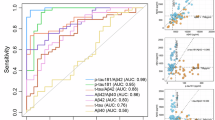Abstract
Central nervous system (CNS) adrenergic systems are involved in regulation of behavior and blood pressure. The effects of Alzheimer's disease (AD) and normal aging on resting CNS adrenergic activity were estimated by measuring cerebrospinal fluid (CSF) epinephrine (EPI) concentrations in 74 persons with AD, 42 cognitively normal healthy older persons, and 54 healthy young persons. The responsiveness of CSF EPI to the alpha-2 adrenergic antagonist yohimbine and the alpha-2 adrenergic agonist clonidine was measured in smaller subject groups. Resting CSF EPI was higher in AD than in older or young subjects, and increased with dementia severity in AD subjects. There was no relationship between resting CSF EPI and blood pressure. CSF EPI increased following yohimbine in AD and older subjects but not in young subjects. CSF EPI was unaffected by clonidine in all subject groups. The agitation increase following yohimbine was substantially greater in AD subjects than in older or young subjects. CNS adrenergic activity seems increased in AD, may further increase as AD progresses, and may be involved in the pathophysiology of agitation.
Similar content being viewed by others
Log in or create a free account to read this content
Gain free access to this article, as well as selected content from this journal and more on nature.com
or
References
Acheson AL, Zigmond MJ . (1981): Short- and long-term changes in tyrosine hydroxylase activity in rat brain after substantial destruction of central noradrenergic neurons. J Neurosci 1: 493–504
Acheson AL, Zigmond MJ, Stricker EM . (1980): Compensatory increase in tyrosine hydroxylase activity in rat brain after intraventricular injections of 6-hydroxydopamine. Science 207: 537–540
Burke WJ, Chung HD, Marshall GL, Gillespie KN, Joh TH . (1990): Evidence for decreased transport of PNMT protein in advanced Alzheimer's disease. JAGS 38: 1275–1282
Burke WJ, Galvin NJ, Chung HD, Stoff SA, Gillespie KN, Cataldo AM, Nixon RA . (1994): Degenerative changes in epinephrine tonic vasomotor neurons in Alzheimer's disease. Brain Res 661: 35–42
Elrod R, Peskind ER, DiGiacomo L, Brodkin KI, Veith RC, Raskind MA . (1997): Effects of Alzheimer's disease severity on cerebrospinal fluid norepinephrine concentration. Am J Psychiat 154: 25–30
Esler MD, Kaye DM, Thompson J, Jennings G, Cox H, Turner AG, Lambert G, Seals D . (1995a): Effects of aging on epinephrine secretion and regional release of epinephrine from the human heart. J Clin Endocrinol Metab 80: 435–442
Esler MD, Turner AG, Kaye DM, Thompson JM, Kingwell BA, Morris M, Lambert GM, Jennings GL, Cox HS, Seals DR . (1995b): Effects of aging on human sympathetic neuronal function. Am J Physiol 268: R278–285
Evans MI, Halter JB, Porte D Jr . (1978): Comparison of double- and single-isotope enzymatic derivative methods for measuring catecholamines in human plasma. Clin Chem 24: 567
Folstein MF, Folstein SE, McHugh PR . (1975): Mini-mental state: A practical method for grading the cognitive state of patients for the clinician. J Psychiat Res 12: 189–198
Fuller RW . (1982): Pharmacology of brain epinephrine neurons. Ann Rev Pharmacol Toxicol 22: 31–55
Gianutsos G, Moore KE . (1978): Epinephrine contents of sympathetic ganglia and brain regions of spontaneously hypertensive rats of different ages. Pro Soc Exp Biol Med 158: 45–49
Introini-Collison I, Saghafi D, Novack GD, McGaugh JL . (1992): Memory-enhancing effects of post-training dipivefrin and epinephrine: Involvement of peripheral and central adrenergic receptors. Brain Res 572: 81–86
Kalia M, Fuxe K, Goldstein M . (1985): Rat medulla oblongata. III. Adrenergic (C1 and C2) neurons, nerve fibers and presumptive terminal processes. J Comp Neurol 233: 333–349
Le Corre PA, Peskind ER, Chevanne F, Raskind MA, Le Verge R . (1997): Cerebrospinal fluid and plasma disposition of yohimbine and 11-hydrox-yohimbine in young and older healthy subjects and Alzheimer's disease patients. Eur J Clin Pharmacol 52: 135–138
Lewis SJ, Rowe P, Jarrott B . (1988): Involvement of hypothalamic adrenaline in the clonidine withdrawal syndrome in normotensive and spontaneously hypertensive rats. Clin Expl Pharmacol Physiol 15: 773–780
Li YW, Bayliss DA, Guyenet PG . (1995): C1 neurons of neonatal rats: Intrinsic beating properties and α2-adrenergic receptors. Am J Physiol 269: R1356–R1369
McKhann G, Drachman D, Folstein M, Katzman R, Price D, Stadian EM . (1984): Clinical diagnosis of Alzheimer's disease: Report of the NINCDS–ADRDA Work Group under the auspices of Department of Health and Human Services Task Force on Alzheimer's disease. Neurology 34: 939–944
Morrow LA, Linares OA, Hill TJ, Sanfield JA, Supiano MA, Rosen SG, Halter JB . (1987): Age differences in the plasma clearance mechanism for epinephrine and norepinephrine in humans. J Clin Endo Metab 65: 508–511
Murburg MM, Villacres EC, Ko GN, Veith RC . (1991): Effects of yohimbine on human sympathetic nervous system function. J Clin Endo Metab 73: 861–865
Nakamura S, Sakaguchi T . (1990): Development and plasticity of the locus coeruleus: A review of recent physiological and pharmacologic experimentation. Prog Neurobiol 34: 505–526
Overall JE, Beller SA . (1983): The Brief Psychiatric Rating Scale (BPRS) in geropsychiatric research I: Factor structure on an inpatient unit. J Gerontol 39: 187–193
Overall JE, Gorham DR . (1962): The Brief Psychiatric Rating Scale. Psychol Rep 10: 799–812
Peskind ER, Wingerson D, Murray S, Pascualy M, Dobie DJ, Le Corre P, Le Verge R, Veith RC, Raskind MA . (1995): Effects of Alzheimer's disease and normal aging on cerebrospinal fluid norepinephrine responses to yohimbine and clonidine. Arch Gen Psychiat 52: 774–782
Reisberg B, Borenstein J, Salob SP, Ferris SH, Franssen E, Georgotas A . (1987): Behavioral symptoms in Alzheimer's disease: Phenomenology and treatment. J Clin Psychiat 48: 9–15
Russo-Neustadt A, Cotman CW . (1997): Adrenergic receptors in Alzheimer's disease brain: Selective increases in the cerebella of aggressive patients. J Neurosci 17: 5573–5580
Schmidt ME, Matuchik JA, Goldstein DS, Schouten JL, Zametkin JA, Potter WZ . (1997): Gender differences in brain metabolic and plasma catecholamine responses to alpha-adrenoreceptor blockade. Neuropsychopharmacology 16: 298–310
Shankle WR, Nielson KA, Cotman CW . (1995): Low-dose propranolol reduces aggression and agitation resembling that associated with orbitofrontal dysfunction in elderly demented patients. Alz Dis Assoc Dis 9: 233–237
Vitiello B, Veith RC, Molchan SE, Martinez RA, Lawlor BA, Radcliffe J, Hill JL, Sunderland T . (1993): Autonomic dysfunction in patients with dementia of the Alzheimer's type. Biol Psychiat 34: 428–433
Weil-Malherbe H, Axelrod J, Tomchick R . (1959): Blood–brain barrier for adrenaline. Science 129: 1226–1227
Weiler PG, Mungas D, Bernick C . (1988): Propranolol for the control of disruptive behavior in senile dementia. J Geriatr Psychiat Neurol 1: 226–230
Wilkie FL, Halter JB, Prinz PN, Benedetti C, Eisdorfer C, Atwood B, Yamasaki D . (1985): Age-related changes in venous catecholamines basally and during epinephrine infusion in man. J Gerontol 40: 133–140
Yudofsky S, Williams D, Gorman J . (1981): Propranolol in the treatment of rage and violent behavior in patients with chronic brain syndromes. Am J Psychiat 138: 218–220
Author information
Authors and Affiliations
Rights and permissions
About this article
Cite this article
Peskind, E., Elrod, R., Dobie, D. et al. Cerebrospinal Fluid Epinephrine in Alzheimer's Disease and Normal Aging. Neuropsychopharmacol 19, 465–471 (1998). https://doi.org/10.1016/S0893-133X(98)00054-2
Received:
Revised:
Accepted:
Issue date:
DOI: https://doi.org/10.1016/S0893-133X(98)00054-2
Keywords
This article is cited by
-
Cerebrospinal fluid catecholamines in Alzheimer’s disease patients with and without biological disease
Translational Psychiatry (2022)
-
Alois Alzheimer revisited: differences in origin of the disease carrying his name
Journal of Neural Transmission (2006)



